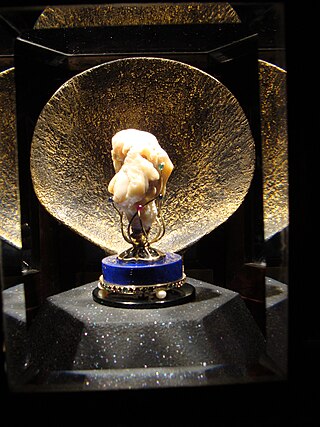Related Research Articles

The Tao Te Ching or Laozi is a Chinese classic text and foundational work of Taoism traditionally credited to the sage Laozi, though the text's authorship, date of composition and date of compilation are debated. The oldest excavated portion dates to the late 4th century BCE, but modern scholarship dates other parts of the text as having been written—or at least compiled—later than the earliest portions of the Zhuangzi; the writers of the first part of the Zhuangzi do not demonstrate familiarity with it.

A pearl is a hard, glistening object produced within the soft tissue of a living shelled mollusk or another animal, such as fossil conulariids. Just like the shell of a mollusk, a pearl is composed of calcium carbonate in minute crystalline form, which has deposited in concentric layers. The ideal pearl is perfectly round and smooth, but many other shapes, known as baroque pearls, can occur. The finest quality of natural pearls have been highly valued as gemstones and objects of beauty for many centuries. Because of this, pearl has become a metaphor for something rare, fine, admirable and valuable.

Laozi, also romanized as Lao Tzu and various other ways, was a semi-legendary ancient Chinese philosopher, author of the Tao Te Ching, the foundational text of Taoism along with the Zhuangzi. Laozi is a Chinese honorific, typically translated as "the Old Master". Modern scholarship generally regards his biographical details as invented, and his opus a collaboration. Traditional accounts say he was born as Li Er in the state of Chu in the 6th century BC during China's Spring and Autumn period, served as the royal archivist for the Zhou court at Wangcheng, met and impressed Confucius on one occasion, and composed the Tao Te Ching in a single session before retiring into the western wilderness.

Palawan, officially the Province of Palawan, is an archipelagic province of the Philippines that is located in the region of Mimaropa. It is the largest province in the country in terms of total area of 14,649.73 km2 (5,656.29 sq mi). The capital and largest city is Puerto Princesa wherein it is geographically grouped but administered independently from the province. Palawan is known as the Philippines' Last Frontier and as the Philippines' Best Island.

El Nido, officially the Municipality of El Nido, is a 1st class municipality in the province of Palawan, Philippines. According to the 2020 census, it has a population of 50,494 people.

Cultured pearls are pearls which are formed within a cultured pearl sac with human intervention in the interior of productive living molluscs in a variety of conditions depending upon the mollusc and the goals. Having the same material as natural pearls, cultured pearls can be cultivated in seawater or freshwater bodies. Over 95% of the pearls available on the market are cultured pearls.

Brooke's Point, officially the Municipality of Brooke's Point, is a 1st class municipality in the province of Palawan, Philippines. According to the 2020 census, it has a population of 73,994 people.

Tridacna gigas, the giant clam, is the most well-known species of the giant clam genus Tridacna. Giant clams are the largest living bivalve mollusks. Several other species of "giant clams" in the genus Tridacna, are often misidentified as Tridacna gigas.

The Gemological Institute of America (GIA) is a nonprofit institute based in Carlsbad, California. It is dedicated to research and education in the field of gemology and the jewelry arts. Founded in 1931, GIA's mission is to protect buyers and sellers of gemstones by setting and maintaining the standards used to evaluate gemstone quality. The institute does so through research, gem identification, diamond grading services, and a variety of educational programs. Through its library and subject experts, GIA acts as a resource of gem and jewelry information for the trade, the public and media outlets.

Tridacna is a genus of large saltwater clams, marine bivalve molluscs in the subfamily Tridacninae, the giant clams. Many Tridacna species are threatened. They have heavy shells, fluted with 4 to 6 folds. The mantle is often brightly coloured. They inhabit shallow waters of coral reefs in warm seas of the Indo-Pacific region. These clams are popular in marine aquaria, and in some areas, such as the Philippines, members of the genus are farmed for the marine aquarium trade. They live in symbiosis with photosynthetic algae (zooxanthellae). Some species are eaten by humans.

Unionida is a monophyletic order of freshwater mussels, aquatic bivalve molluscs. The order includes most of the larger freshwater mussels, including the freshwater pearl mussels. The most common families are the Unionidae and the Margaritiferidae. All have in common a larval stage that is temporarily parasitic on fish, nacreous shells, high in organic matter, that may crack upon drying out, and siphons too short to permit the animal to live deeply buried in sediment.

The Zhuangzi is an ancient Chinese text that is one of the two foundational texts of Taoism, alongside the Tao Te Ching. It was written during the late Warring States period (476–221 BC) and is named for its traditional author, Zhuang Zhou.

Pearl Maxima is one of the largest true pearls or nacreous pearls in the world. This irregularly shaped pearl has a weight of 2385 grains and is 71 millimetres long. Its colour varies from cream to gold.

Melo melo, common name the Indian volute or bailer shell, is a very large edible sea snail, a marine gastropod mollusc in the family Volutidae, the volutes.
The Pearl of Puerto, also known as the Pearl of Puerto Princesa, is an unauthenticated pearl that was found in the Philippine Sea by a Filipino fisherman. It measures 2.2 feet (67 cm) long, 1 foot (30 cm) wide and weighs 34 kilograms (75 lb).

The archaeology of the Philippines is the study of past societies in the territory of the modern Republic of the Philippines, an island country in Southeast Asia, through material culture.
Taoist art relates to the Taoist philosophy and narratives of Lao-tzu that promote "living simply and honestly and in harmony with nature."

The Giga Pearl holds the record as the largest certified non-nacreous pearl in the world. The pearl weighs in at 27.65 kg and measures 39.37 cm × 22.86 cm × 20.95 cm, which is four times larger than the Pearl of Lao Tzu which weighs 6.4 kg. There have been claims of "the world's largest pearl" in recent years, however, only the Giga Pearl holds the title on record as the world's largest GIA certified natural blister pearl, making it indisputably the largest in the world.

Larisa Popova is an Italian gemologist, appraiser and jeweler.
References
- 1 2 "The Pearl of Allah: The Facts, the Fiction, and the Fraud". Pearl Guide. July 20, 2014. Retrieved October 21, 2019.
- ↑ Wilburn Dowell Cobb (November 1939). "The Pearl of Allah". Natural History.
- ↑ "Manatee County Probate".[ dead link ]
- ↑ The Pearl Book Archived July 23, 2011, at the Wayback Machine , International Jewellery Confederation.
- ↑ GIA Gems & Gemology magazine news archive, December 3, 2008 (archived from the original on December 4, 2008)
- ↑ "Jewelry, Precious Metals, and Pewter Industries". Federal Trade Commission. February 11, 2014. Retrieved June 28, 2024.
- ↑ Palawan Princess – 5 Pound Pearl – Up for Auction [ dead link ] (archived from the original on January 16, 2016), karipearls.com, December 6, 2009.
- ↑ Auction catalog beginning with lot no. 2377, Bonhams Natural History Auction, December 6, 2009, Bonhams Auction House.
- ↑ Sale Results, Sale 17535, Natural History, December 6, 2009, Bonhams Auction House. Archived December 12, 2010, at the Wayback Machine